Community Planning: Methods
Briefing workshop
- description
- more detail
- more pictures
Briefing workshops are simple, easy-to-organise working sessions held to establish a project agenda or brief. Simultaneously they can:
- introduce people to the project;
- help establish the key issues;
- get people involved and motivated;
- identify useful talent and experience;
- identify the next steps needed.
They are useful at the start of a project or action planning event and can act as a public launch.
Potential users of the project are invited to attend a workshop, usually lasting around 1.5 hours. Similar workshops may be held with
different interest groups (eg: staff, leaders, young people, etc) or on different topics (eg: housing, jobs, open space, etc).
The workshop is facilitated by one or more individuals who will have planned a format to suit the context
A record is kept of those who attend, the points made and key issues identified.
People's contributions are unattributable unless agreed otherwise.
Photocredits
1: Blairs College, Aberdeen, UK 1994
John Thompson & Partners
2 & 3: Holy Trinity Brompton, London, UK 1997, Nick Wates
4: Wornington Green, London, UK 1989,
John Thompson & Partners
1: Blairs College, Aberdeen, UK 1994
John Thompson & Partners
2 & 3: Holy Trinity Brompton, London, UK 1997, Nick Wates
4: Wornington Green, London, UK 1989,
John Thompson & Partners
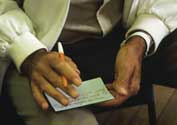
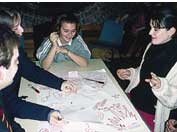
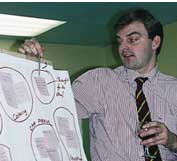
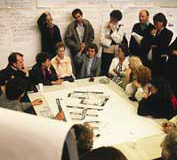
Main steps
- Individual brainstorm on Post-it notes or cards;
- Categorising in small groups sitting round a table or on the floor;
- Presenting the results;
- General discussion and planning the next steps.
Tips
- If people find it hard to get started, say "Just write down the first thing that comes into your head, however big or small."
- The record should ideally include typing up all Post-it notes and flip-chart sheets as well as key points from all debate.
- Follow up by circulating a summary to all participants.
Costs
- Core costs: Facilitator's fees; venue hire; typing up workshop notes (allow one person day per workshop).
Briefing workshop format
Sample covering most contexts.
Sample covering most contexts.
- Introduction
Purpose of event explained by facilitator. Everyone introduces themselves and explains briefly their interest. Notetaker and flipcharter identified. (15 mins) - Individual brainstorm
Everyone is given Post-it notes or cards of 3 different colours and asked to write down their responses, in relation to any given topic, to 3 questions:
• What is wrong?
• What is your dream?
• How can it happen?
Each Post-it note should contain only one response. A limit can be set for the number of responses per person to make the total manageable. Symbols can be used if people are illiterate. (15 mins) - Categorising
People divide into three sub-groups. Each sub-group categorises Post-its of one colour by arranging them on large sheets of paper and making headings. Graphics can be added if helpful. (20 mins) - Presenting
Each sub-group explains its findings to the whole group. (20mins) - Discussion
On the results and next stage in the process. Strategic recommendations and immediate action identified. (20 mins)
If the workshop is part of a larger community planning event, a report back will then be made to a plenary session.
Running time: 1.5 hours.
Ideal numbers: 9 24. With larger numbers, split up into more subgroups for categorising or have a facilitating team doing the categorising.
Briefing workshop props
checklist
- Attendance sheets
- Banners with workshop title
- Display material, eg maps, photos, plans
- Flip-chart (or paper on wall)
- Felt-tip markers (or chalk)
- Pens or pencils
- Post-it notes (or small pieces of paper or card) in three colours
- Tape (or drawing pins or Blu-tack)
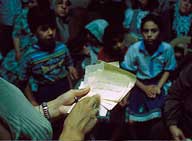
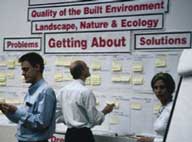
Facilitated categorising
A team of facilitators (who may be volunteers) read out responses one by one and place them in categories on wall sheets. An alternative to the procedure outlined in the first two tabs, useful when there are large numbers.
Photocredits
left: Sidon, Lebanon, 1997, John Thompson and Partners
right: Liverpool, UK, 1997, Nick Wates.
left: Sidon, Lebanon, 1997, John Thompson and Partners
right: Liverpool, UK, 1997, Nick Wates.
Thanks: John Thompson & Partners

